| |
|
Belsey
Bridge Conference Centre, Ditchingham
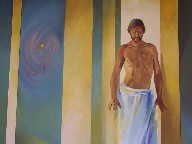 |
|
Part
of the Anglican revival in the 19th Century
involved the establishment of religious
communities. The idea of monks and nuns, set
apart and living consecrated lives, was totally
anathema to protestantism, so you may imagine the
controversy generated in the 1850s when a
community of Sisters took up residence in the
Ditchingham countryside. However, the All Hallows
community flourished, and by the end of the 19th
century they were not only running a hospital, an
orphanage and a home for fallen women, but also a
school. Here, in the narrow, winding lanes
of Ditchingham parish, barely two miles from
Bungay but with the feeling of one of the most
remote spots in all East Anglia, survives today a
complex of late 19th and early 20th Century red
brick gothic buildings, and one of them is the
former school, a maze of corridors connecting
what were once separate buildings. The chapel of
the school was rebuilt in 1960 in memory of
Herbert Palmer, Warden of the Community of All
Hallows and Chaplain to the school. It is a
large, light, airy building, absolutely typical
of its date: ten years earlier and there would
have been more of a sense of a shadowy past, and
ten years later it would have responded to the
reforms of Vatican II (despite being Anglican) by
having an altar in the centre rather than at the
east end.
|
The main
focus and great highlight of the chapel is the vast mural
reredos depicting Revelations of Divine Love, based
on the writings of Julian of Norwich, by the Australian
artist Alan Oldfield. It was installed here in 1989. This
is outstanding, one of the major religious artworks in
East Anglia of the 20th Century.
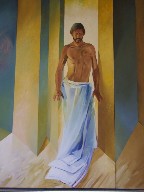 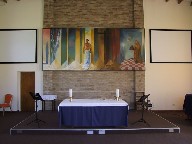
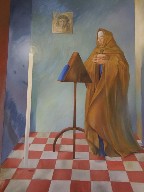
At the
installation of the piece, Oldfield observed that this
painting is my way of paying back what I have learned
from Julian of Norwich. She is not a very visual mystic,
but as she struggled to put her vision into words, so I
have struggled to clarify in paint what I feel about her
work. The two main figures are Julian herself on the far
right of the painting, her reading desk in front of her
and vernicle on the wall behind. At the centre is the
risen Christ, emerging from folds in the universe. At the
far left a shadow falls, and there are other references
to what she described in her visions.
| The
former chapel, in the main buildings, was split
in two with a false floor, the lower half
becoming the library and the upper floor into
bedrooms. However, the school closed about ten
years ago, and became for a while the St
Gabriel's Retreat Centre. In 2009 the buildings
were taken over by an Anglican trust, and
rebadged as Belsey Bridge Conference Centre. The complex
still serves as a place for private and group
retreats, but is also available to churches of
all denominations for meetings and other
get-togethers. The chapel was reordered slightly:
the floor was carpeted, the old furnishings were
removed and replaced with modern chairs. Overhead
projectors and screens were installed, not only
to meet the needs of conferences, but also the
demands of modern liturgical forms of worship.
The altar and other sanctuary furnishings can be
easily removed if the chapel, the largest room in
the complex, is required for secular use.
However, I was pleased to find one of the old All
Hallows prayer desks with its embroidered kneeler
still in the corner of the sacristy.
|
|
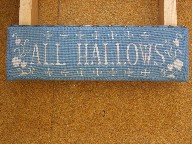 |
|
|
|
